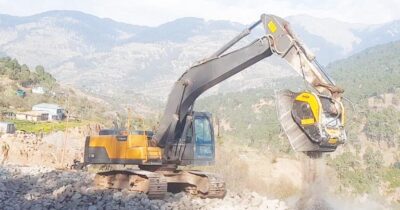Outsourcing building projects to specialist businesses, using prefabricated materials, and incentives for early project completion are all trends in the construction equipment market, says Dr. Piero Guizzetti, CEO of MB Crusher India Pvt. Ltd.
What types of construction equipment are required to meet quality and speedy construction requirements?
There is no one-size-fits-all answer to this question, as the type of construction equipment required to meet quality and speedy construction requirements will vary depending on the project’s complexity and site location. In our specific segment, hydraulic parameters are of utmost importance. Flow is correlated to the performance of our bucket crusher and our drum cutters and trenching units. Generally, quality is achieved with the latest technology and an unwavering commitment to quality components. For example, at MB, we use the industry’s best material for our jaw plates, which is the most expensive consumable in crushing operations.
On the other hand, speed is achieved when one can create working conditions whereby the highest degree of independence is achieved while maintaining economic viability. Our attachments transform any HEX or BHL into a crushing, screening, and trenching unit, even in the remotest of locations without electricity or generator equipment. All without compromising on the quality of crushed output material or the precision of trenching and screening operations.

What are the present procurement trends in construction, mining, concrete, and equipment for efficient project completion?
In the current construction landscape, there is an increased focus on efficiency to complete projects on time and within budget. Outsourcing construction work to specialist firms, using prefabricated materials, offering incentives for early completion, and implementing just-in-time delivery are major trends we see in the Indian market. New cutting-edge technologies, such as 3D printing and drones for surveying potential construction sites, as well as digital tools and platforms for project management and procurement, are also about to enter the Indian market.
What are the procurement challenges in your business? What measures are being taken to iron out those issues?
BFSI support has been a bit lacklustre since the pandemic. The balance sheets of these institutions have deteriorated, making them more selective in terms of giving out credit. This has led to procurement delays at the general level. Contractors’ cash flows have also taken a hit due to payment delays by private and/or implementing public authorities. The Central Government is now helping state bodies prioritise infrastructure projects and ensure that financing is in place to kick-start projects in an expedited manner.
With the infrastructure sector becoming smart and intelligent, which technologies drive efficiency at project sites?
The infrastructure sector is driven by new technologies that allow for better communication, coordination, and overall management of projects. Some of the key technologies driving this efficiency are cloud-based project management platforms, which allow for real-time collaboration and tracking of progress; drones and other autonomous vehicles, which can help with mapping and surveying; and 3D printing, which is being used to create prototypes and test products before they are mass manufactured. To improve efficiency, we are also discovering new technologies like AR and VR, IoT-based devices, data analysis systems, and artificial intelligence.
Electric and battery-operated equipment is also a crucial part of intelligent equipment. How do you foresee the demand and supply for the same in the coming years?
The rising popularity of electric and battery-operated equipment results from its many benefits. These include being more environmentally friendly, having a quieter operation, and often having a lower price point than their gasoline-powered counterparts. However, a few factors could impact the supply of these devices. Firstly, the manufacturing process for electric and battery-operated equipment is often more complex and expensive than traditional methods. This could lead to higher consumer prices, putting a damper on demand. Additionally, batteries can be challenging to recycle correctly, meaning there may need to be a reliable supply of raw materials for manufacturers to use in the future. Despite these potential challenges, the demand for electric and battery-operated equipment will likely continue to grow as the world becomes increasingly focused on sustainability.
Cookie Consent
We use cookies to personalize your experience. By continuing to visit this website you agree to our Terms & Conditions, Privacy Policy and Cookie Policy.


















